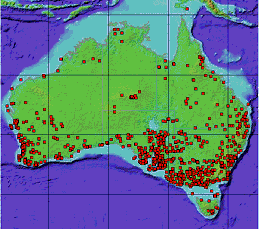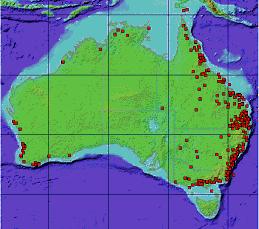Family: - Solanaceae.
Names:Other names:
Black NightshadeSummary:
Blackberry Nightshade is an erect herb or small short-lived bushy shrub to 1 m high. The leaves are 2-7.5 cm long, entire or very shallowly lobed. The flowers are white, in short-stalked clusters of 4-12 flowers. Each flower is star-shaped and about 10 mm across with 5 spreading white petals. The succulent, globular berries are usually 6-8 mm across, at first green but becoming dull black at maturity. Each berry contains 25-35 seeds about 2 mm long.Description:
A morphologically variable species.Cotyledons:
Two. Oval, green on top with purple tinges underneath, 13-17 mm long overall with a petiole 4 to 5 mm long, acute tip. Base tapered. Glandular, short hairs are normally present on the upper and lower surfaces of the blade or along the edges, on the petiole and hypocotyl. The seedling has a green hypocotyl often with purple tinges. It has no epicotyl. No veins on the upper surface, mid vein a green line on the lower surface.First Leaves:
The leaves grow singly, the first being oval, 18-25 mm long overall, acute tipped with a petiole 5-8 mm long. Base tapered to squarish. Glandular hairs are present on the upper and lower surfaces or edges and on the petiole. Short, stout non-glandular hairs occur on the upper leaf surface also. Prominent veins.Leaves:
Alternate. Does not develop as a rosette. Later leaves are generally similar in shape to the first leaf, though as the plant grows they become more diamond shaped.Stems:
Erect, 200-1000 mm long, stout, green or tinged with purple to quite dark, branch from the base and along their length, solid and circular or polygonal in cross-section with one or more longitudinal ridges which often carry tubercles. Few curved or glandular, low lying, hairs or no hairs are present. Often shrubby, sometimes woody at the base. No spines. Stem architecture is quite dependent on the environment.Flower head:
Extra axillary (arise from the stem above the leaf axil), 3-12 flowers in umbel like cymes or racemes. Common stalk(peduncle), 10-25 mm long carrying flower stalks(pedicels), 5-10 mm long. Peduncle and pedicels bent downwards when in fruit.Flowers:
Star shaped, 4 to 18 mm in diameter, with five white petals and yellow anthers. Self fertilising.Fruit:
Soft, juicy, globular, drooping berry, 5-10 mm diameter. Normally starts off green and turns dull black or purplish in colour.Seeds:
Yellow to dark brown. Tear drop shape in outline, flattened, 25-35 per berry, 1-2.2 mm long. Surface finely network patterned, and hairless.Roots:
Light coloured taproot and many laterals. High shoot:root ratio.Key Characters:
Erect annual or rarely biennial.Biology:
Life cycle:Physiology:
Produces alkaloids, glycosides and accumulates nitrates.Reproduction:
By seed.Flowering times:
Most of the year in WA.Seed Biology and Germination:
Produces dormant seed.Vegetative Propagules:
None.Hybrids:
Plants are primarily self fertilising.Allelopathy:
Ecology, Population Dynamics and Dispersal:Origin and History:
Europe. Cosmopolitan.Distribution:
ACT, NSW, NT, QLD, SA, TAS, VIC, WA.

| Solanum nigrum distribution. | Solanum americanum distribution. |
Habitats:
Prefers shaded areas.Climate:
Temperate. Mediterranean.Soil:
Wide range.Plant Associations:
Many.Significance:
One of the worlds worst weeds (Holm) being a weed of 37 crops in 61 countries.Beneficial:
Mature fruit used for jam.Detrimental:
Weed of fallows, cultivation, vegetables, pasture, gardens, stock yards, disturbed woodlands, streams, wetlands and disturbed areas.Toxicity:
Considered variably toxic overseas and a few field cases of toxicity in have been reported in Australia.Symptoms:
Glycoside poisoning; Abdominal pain, vomiting, constipation or diarrhoea, blood stained faeces, loss of appetite, death or recovery.Treatment:
Remove stock from infestations. Avoid releasing hungry stock onto dense infestations.Legislation:
None.Management and Control:
Blackberry Nightshade is seldom a problem in well-managed pastures. It usually results from bared soil in the late spring to early summer period. In summer crops there are a number of selective herbicides for various situations.Thresholds:
Very low in processing peas.Eradication strategies:
Prevent seed set for several years.Herbicide resistance:
Some populations have developed resistance to atrazine.Biological Control:
Related plants:Plants of similar appearance:
This plant is often incorrectly identified as the highly toxic Deadly Nightshade (Atropa bella-donna) which does not occur in Australia.References:
Auld, B.A. and Medd R.W. (1992). Weeds. An illustrated botanical guide to the weeds of Australia. (Inkata Press, Melbourne). P230. Photo.Acknowledgments:
Collated by HerbiGuide. Phone 08 98444064 or www.herbiguide.com.au for more information.